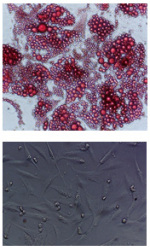July 1, 2015 by Frederic Dubor. Mechanisms leading to cellulite formation is complex. It involves lipid regulatory pathways and proinflammatory cross-talk that represent promising molecular targets in cosmetology. This post introduces a clever in vitro adipocyte-based assay targeting adipocytokines to better determine the anti cellulite effects of cosmetics compounds.
Among all the molecular pathways followed by skin care professionals, adipolysis / adipogenesis balance in adipocyte tissues is undoubtely one the most attractive ones. Lipolysis induction transforms Triglycerides (TG) contained in adipocytes into Free Fatty Acid (FFA) and Gycerol. It decreases adipocyte size and reduces cellulite phenomenon. Research programs in cosmetology track and record any data related to active compound able to induce direct lipolysis.
In parallel, PPARγ is another key target in cellulite modulation. PPARγ is involved in adipocytes differentiation. Cosmetics strive to identify PPARγ inhibitors to also reduce the number of mature adipocyte tissues stocking fats and located under the skin.
Contact









 Follow us on Linkedin!
Follow us on Linkedin!
You must be logged in to post a comment.